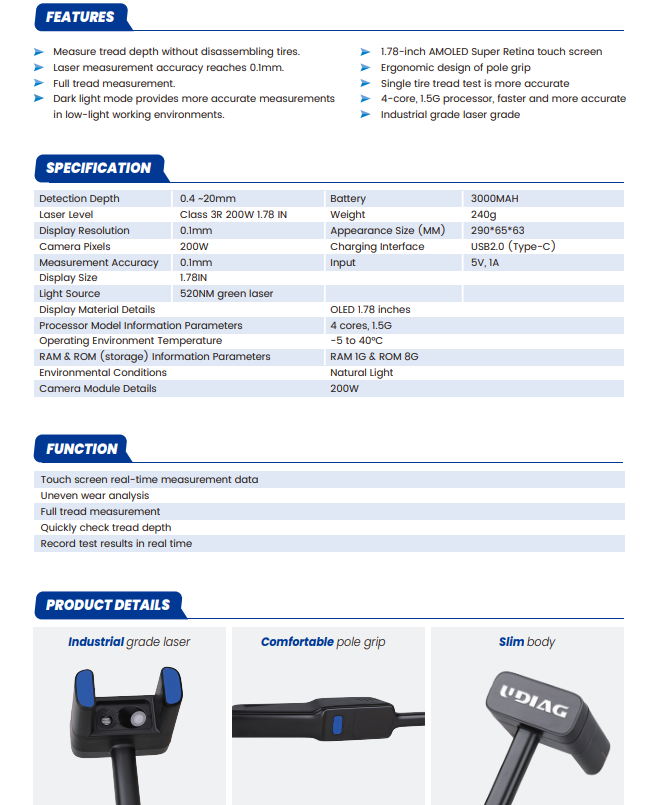Are tire tread detectors capable of detecting tire damage caused by road hazards or debris?
2024-03-25 by UDIAG
Tire tread detectors represent a crucial technological advancement in vehicle safety, aiming to identify and mitigate potential risks posed by damaged tires. One of the primary concerns addressed by these detectors is the detection of tire damage caused by road hazards or debris. This essay evaluates the effectiveness of tire tread detectors in identifying damage resulting from road hazards, highlighting their significance in enhancing road safety.

I. Understanding Tire Damage from Road Hazards
Road hazards encompass various obstacles and debris encountered during vehicle operation, including potholes, sharp objects, and debris on roadways. These hazards pose a significant threat to tire integrity, leading to various forms of damage such as punctures, cuts, and sidewall bulges. Detecting such damage promptly is crucial for preventing accidents and ensuring vehicle performance and safety.
II. Mechanisms of Tire Tread Detectors
Tire tread detectors employ diverse technologies, including visual inspection systems, tread depth sensors, and pressure monitoring systems, to assess tire condition. These systems utilize sensors and algorithms to analyze tire tread patterns, depth, and pressure variations, aiming to detect abnormalities indicative of damage. However, the efficacy of these detectors may vary depending on their design and implementation.
III. Factors Affecting Detection Accuracy
Several factors influence the accuracy of tire tread detectors in identifying damage from road hazards. Vehicle speed, type, and size of road hazards, as well as environmental conditions, can impact detection performance. Additionally, the sensitivity and precision of detection systems play a crucial role in determining their effectiveness in real-world scenarios.
IV. Case Studies and Experimental Data
Numerous studies have assessed the effectiveness of tire tread detectors in detecting road hazard-induced damage. These studies involve real-world experiments conducted under various road conditions, comparing detection rates with and without tire tread detectors. The analysis of empirical data provides insights into the capabilities and limitations of existing detection systems.
V. Improvements and Future Directions
Despite advancements in tire tread detection technology, challenges remain in achieving optimal detection accuracy. Future research should focus on addressing these challenges through technological advancements, such as the integration of machine learning and AI algorithms. Improving the robustness and reliability of detection systems is essential for enhancing road safety and preventing accidents.
VI. Implications and Applications
Reliable tire damage detection has significant implications for vehicle safety, economic costs, and environmental sustainability. Timely identification of damage allows for prompt maintenance and repair, reducing the risk of accidents and minimizing downtime for vehicles. Furthermore, effective detection contributes to overall road safety by preventing tire-related incidents and promoting efficient transportation systems.
Conclusion
In conclusion, tire tread detectors represent a vital tool in identifying tire damage caused by road hazards or debris. While these detectors offer promising capabilities in enhancing road safety, their effectiveness depends on various factors and technological advancements. Continued research and development efforts are necessary to improve detection accuracy and reliability, ensuring the optimal performance of tire tread detection systems in real-world scenarios. By addressing these challenges, tire tread detectors can play a pivotal role in mitigating risks associated with road hazards and enhancing overall road safety.
FAQs
1. What are tire tread detectors, and how do they work?
Tire tread detectors are systems designed to assess the condition of a vehicle's tires, primarily focusing on tread depth, patterns, and abnormalities. These detectors utilize various technologies such as sensors and algorithms to analyze tire surfaces and identify potential damage.
2. Can tire tread detectors detect damage caused by road hazards or debris?
Yes, tire tread detectors are capable of detecting damage resulting from road hazards or debris. They can identify abnormalities in the tire tread pattern, changes in tread depth, and other indicators of damage caused by road hazards such as potholes, sharp objects, or debris on roadways.
3. What types of damage can tire tread detectors identify?
Tire tread detectors can identify various types of damage, including punctures, cuts, sidewall bulges, and uneven wear patterns. These detectors are sensitive to changes in tread depth and surface irregularities, allowing them to detect damage caused by road hazards.
4. How accurate are tire tread detectors in detecting road hazard-induced damage?
The accuracy of tire tread detectors in detecting road hazard-induced damage can vary depending on factors such as the design of the detection system, environmental conditions, and the type and size of road hazards. Generally, these detectors can provide reliable indications of tire damage, but their effectiveness may be influenced by several variables.
5. Do tire tread detectors require any maintenance or calibration?
Yes, tire tread detectors may require periodic maintenance and calibration to ensure optimal performance. Regular calibration helps maintain the accuracy of the detection system, while routine maintenance helps prevent malfunctions and ensures reliable operation.
6. Can tire tread detectors prevent accidents caused by road hazards?
While tire tread detectors can help identify damage caused by road hazards, they do not directly prevent accidents. However, by providing early warnings of tire damage, these detectors enable timely maintenance and repairs, reducing the risk of accidents and promoting road safety.


